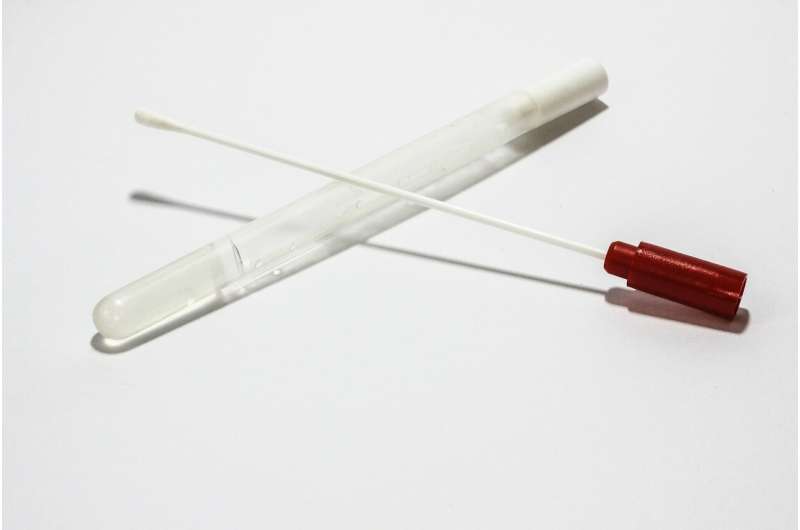Cooperation under pressure: Lessons from the COVID-19 swab crisis

A major crisis that accompanied the rise of the pandemic was lack of availability of the nasopharyngeal swab—necessary for testing for COVID-19, which in turn, was necessary to get a grip on the pandemic. An account of how one group addressed that crisis is published this week Journal of Clinical Microbiology, a journal of the American Society for Microbiology.
"We met the challenge by creating all-new swabs, which were ready and clinically tested in just three weeks," said Ramy Arnaout, M.D., D.Phil., Associate Professor of Pathology, Beth Israel Deaconess Medical Center and Harvard Medical School, and Associate Director of the Clinical Microbiology Laboratories, Beth Israel Deaconess Medical Center (BIDMC).
"Handling crises successfully requires a different set of skills than the everyday," said Dr. Arnaout. "Competition and secrecy are out. Cooperation and openness are in. Resolving the swab crisis was a case study in these and other valuable lessons."
As the first wave of COVID-19 broke out across the United States, BIDMC, which had the largest in-house COVID-19 testing center in Boston, found themselves with only a week's supply of swabs. "More manufacturing was the only lasting solution," Dr. Arnaout said. He and his colleagues began reverse engineering swabs, to determine if they could make them from scratch.
Swabs must be engineered to be neither too stiff, nor too flexible, and must be individually packaged and sterile. BIDMC needed around ten thousand a week; the country needed roughly ten million.
The first week, group members floated, shot down, resurrected, and repurposed various ideas, said Dr. Arnaout. Ultimately, the team saw two options: To find a scalable means to assemble swabs, or else to "find a way to make a stripped-down swab in a single go, without the need for assembly." 3D printing had "advantages in speed of development and in the variety of structures it can make."
Dr. Arnaout had previously demonstrated that open and collaborative crowdsourcing can be a viable route to solving complex computational problems, specifically his work in computational immunology. He put this lesson to work in the COVID crisis.
"We navigated our… networks, letting manufacturers know about the swab crisis and what we needed from them to solve it," said Arnaout. "We set up a free publicly viewable knowledge base online in the form of a GitHub repository—a type of website usually used by software engineers to collaborate on coding projects—to share everything we knew with everyone who might want to know it. This was critical for lowering the activation energy for anyone who wanted to join the effort… By the end of the first week, prototypes were rolling in."
Over the course of the second week, the team tested more than 150 prototypes. "We were giving manufacturers feedback and suggestions one day and receiving new prototypes the next," Dr. Arnaout said. "We put our protocols and results online."
The team spoke often with BIDMC's Institutional Review Board, "whose help and quick feedback were indispensable for cutting through red tape," Dr. Arnaout said. "We put our IRB-approved protocol online as well." BIDMC's technology ventures office assured the team that the evaluation and feedback they were providing to manufacturers would not constitute intellectual property, thereby avoiding any haggling over ownership, which could have wasted precious time."
By the fourth week, the team had validated four prototypes for clinical use. By summer's end, "millions of the swabs our coalition helped design, vet, and mass-produce had been sold and used for COVID-19 testing" across the United States and in Europe, Dr. Arnaout wrote.
That experience suggested five lessons:
- Define the mission—"a simple, clear, and concrete unifying goal for the entire team," said Dr. Arnaout.
- Establish norms for behavior. At BIDMC, that took place "mostly via conversations, repetition of the main message and personal example," said Dr. Arnaout. "Conversations often began or ended with an explicit acknowledgment of the temptation to go it alone... and a reminder that we were not going to give in to such temptation."
- Leverage expertise. "At BIDMC, the clinical trials office handled paperwork that the investigators would have handled themselves under normal circumstances."
- Practice open and clear communication, "by eliminating the friction of gatekeeping access to information," said Dr. Arnaout.
- Stay positive.
"Perhaps we all can take the opportunity afforded by this trying time to improve how we meet our everyday challenges," said Dr. Arnaout. "By doing so, we might find ourselves further along, more capable, and better prepared for when the next crisis inevitably hits."

















